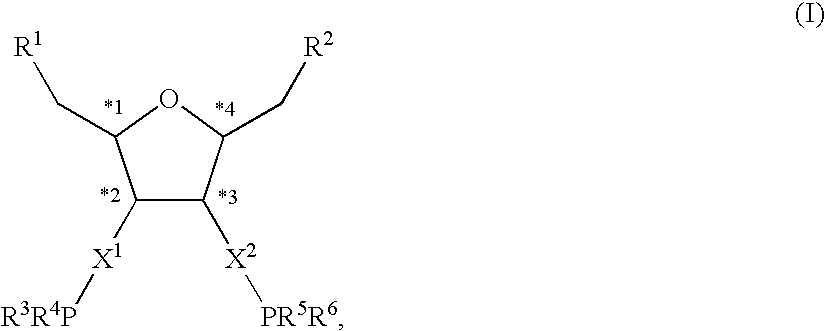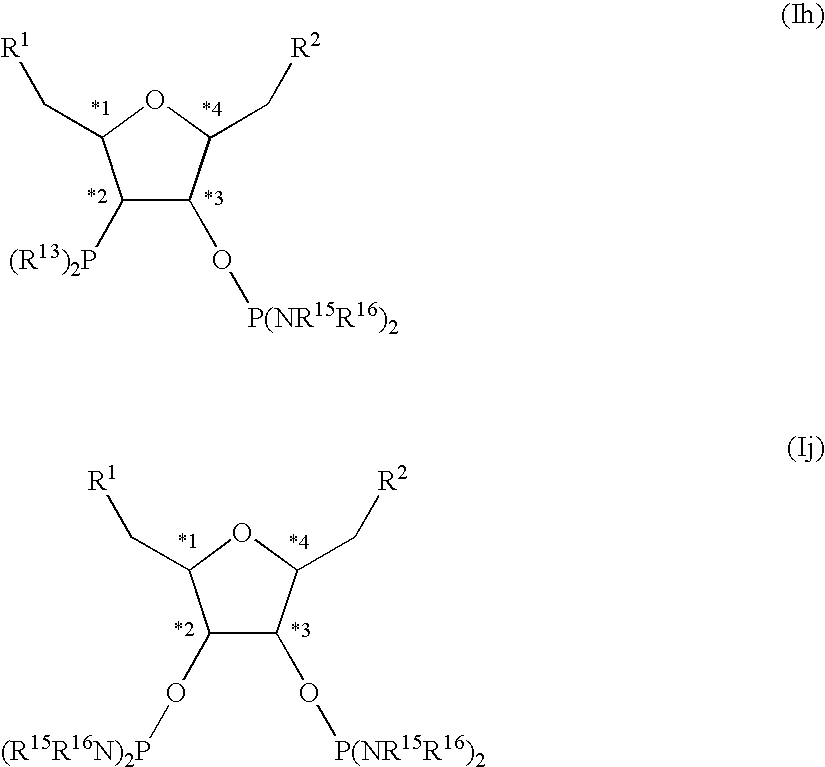Chiral diphosphorus compounds and their transition metal complexes
a technology of transition metal complexes and diphosphorus compounds, which is applied in the direction of group 3/13 element organic compounds, group 5/15 element organic compounds, chemical/physical processes, etc., can solve the problems of uneconomic industrial use of such ligands and the catalysts preparable therefrom, and the steric and electronic variation of the central tetrahydrofuran framework is only possible to a very limited extent, and achieves a high degree of variable electrostatic and steric properties
- Summary
- Abstract
- Description
- Claims
- Application Information
AI Technical Summary
Benefits of technology
Problems solved by technology
Method used
Image
Examples
example 1
1,6-Di-O-(triphenylmethyl)-2,5-anhydro-D-mannitol (B1): a mixture of 2.35 g (14.33 mmol) of 2,5-anhydro-D-mannitol and 8.79 g (31.53 mmol) of triphenylmethyl chloride in 38 ml of pyridine was stirred at 100° C. for 12 hours. After cooling, the mixture was diluted with CH2Cl2, and washed with aq.HCl (0.78 mol / l), the organic phase was dried over Na2SO4 and the solvent was subsequently removed under reduced pressure. The crude product was purified by means of column chromatography (hexane / ethyl acetate 2:1). Yield: 5.57 g (60% of theory).
1H NMR (400 MHz, CHCl3) δ, 7.60-7.03 (m, 15H, Ph), 4.12 (m, 1H, H-2), 3.96 (m, 1H, H-3), 3.45 (dd, 1H, J6,2=3.9 Hz, J6,6′=10.2 Hz, H-6), 3.39 (sa, 1H, OH), 3.22 (dd, 1H, J6′,2=4.2 Hz, J6′,6=10.2 Hz, H-6′); 13C NMR (100.6 MHz) δ, 143.31.-127.02 (Ph), 87.31 (C(Ph)3), 83.63 (C-2), 79.45 (C-3), 64.79 (C-6).
example 2
1,6-Di-O-(tert-butyidiphenylsilyl)-2,5-anhydro-D-mannitol (B2): 3 ml (11.66 mmol) of tert-butyidiphenylsilyl chloride (TBDMPSCI) were added dropwise at 0° C. to a solution of 0.87 g (5.3 mmol) of 2,5-anhydro-D-mannitol and 1.5 g (22.28 mmol) of imidazole in 12 ml of anhydrous DMF. The mixture was heated to room temperature and stirred for a further 25 hours, and the solvent was subsequently removed under reduced pressure. The mixture was diluted with CH2Cl2 and washed with water, the organic phase was dried over Na2SO4 and the solvent was subsequently removed under reduced pressure. The crude product was purified by means of column chromatography (hexane / ethyl acetate 4:1). Yield 1.36 g (40% of theory).
1H NMR (400 MHz, CDCl3) 8, 7.81-7.30 (m, 10H, Ph); 4.25 (m, 1H, H-3); 4.17 (m, 1H, H-2); 4.04 (d, 1H, OH); 3.86 (dd, 1H, J6,2=3.7 Hz, J6,6′=11.1 Hz, H-6); 3.75 (dd, 1H, J6′,2=3.2 Hz, J6,6′=11.1 Hz, H-6′); 1.07 (s, 9H, C(CH3)3); 13C NMR (100.6 MHz) δ, 136.10-126.99 (Ph), 87.09 (C-2),...
example 3
1,6-Di-O-(p-toluenesulphonyl)-2,5-anhydro-D-mannitol (B3): 5.33 g (27.945 mmol) of p-toluenesulphonyl chloride were added at 0° C. to a solution of 2.16 g (13.15 mmol) of 2,5-anhydro-D-mannitol in 88 ml of pyridine. The mixture was heated to room temperature and stirred for a further 24 hours. The reaction was hydrolysed using ice-water and extracted using CH2Cl2, and the combined organic phases were washed with 3N HCl and NaCl. After drying over MgSO4, the solvent was subsequently removed under reduced pressure. The crude product was purified by means of column chromatography (hexane / ethyl acetate 1:2).
Yield: 3.00 g (48% of theory).
1H NMR (400 MHz, CDCl3) δ, 7.82-7.31 (m, 4H, Ph); 4.2-3.9 (m, 4H, H-2, H-3, H-6, H-6′); 2.44 (s, 3H, CH3); 13C NMR (100.6 MHz, CDCl3) δ, 145.05-126.86 (Ph), 80.42 (C-2), 77.32 (C-3), 68.84 (C-6), 21.81 (CH3).
PUM
| Property | Measurement | Unit |
|---|---|---|
| Temperature | aaaaa | aaaaa |
| Temperature | aaaaa | aaaaa |
| Pressure | aaaaa | aaaaa |
Abstract
Description
Claims
Application Information
 Login to View More
Login to View More - R&D
- Intellectual Property
- Life Sciences
- Materials
- Tech Scout
- Unparalleled Data Quality
- Higher Quality Content
- 60% Fewer Hallucinations
Browse by: Latest US Patents, China's latest patents, Technical Efficacy Thesaurus, Application Domain, Technology Topic, Popular Technical Reports.
© 2025 PatSnap. All rights reserved.Legal|Privacy policy|Modern Slavery Act Transparency Statement|Sitemap|About US| Contact US: help@patsnap.com



